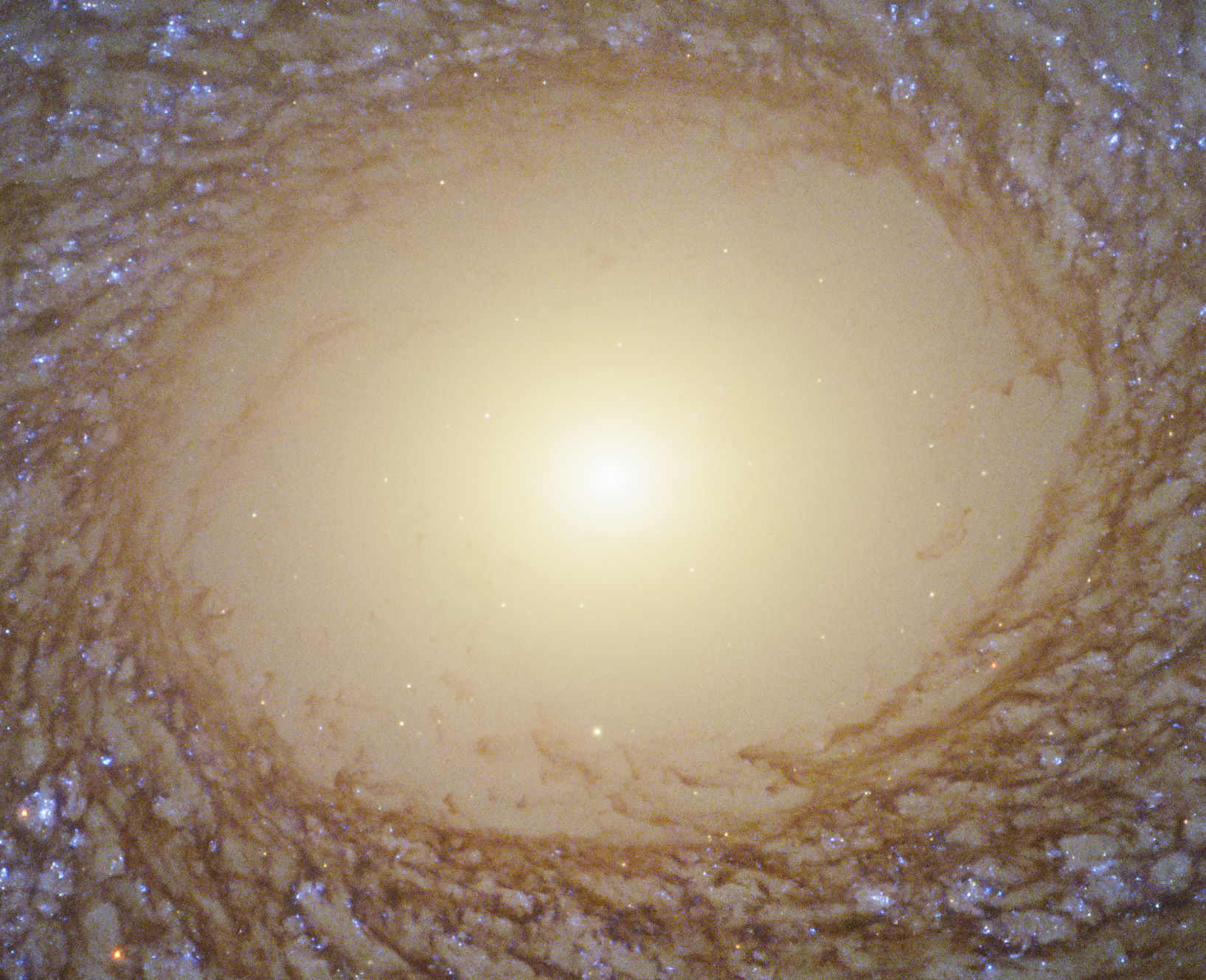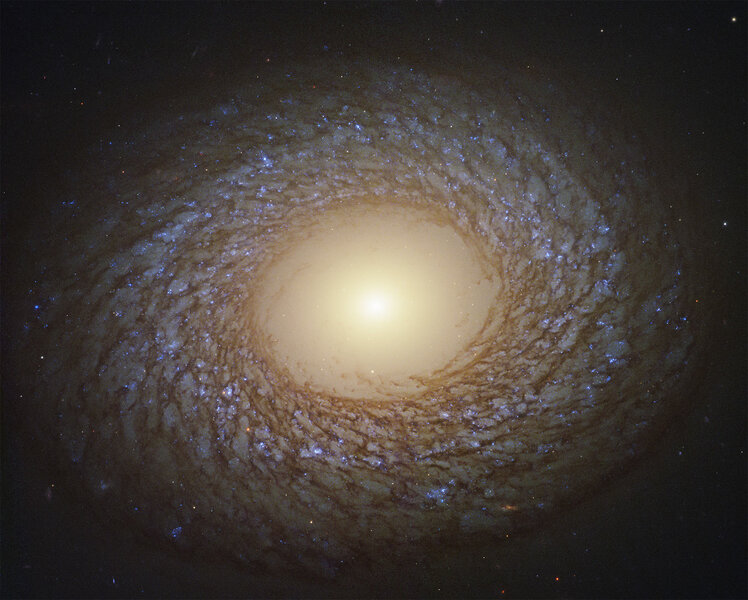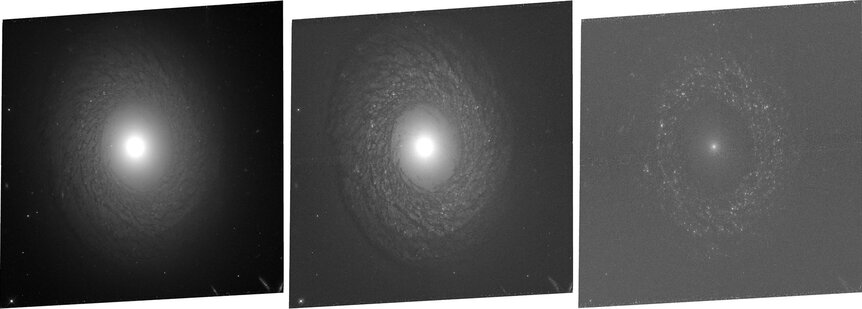Create a free profile to get unlimited access to exclusive videos, sweepstakes, and more!
A flocculent spiral galaxy with a really, really weird middle

One of my favorite things about seeing big splashy gorgeous images of spiral galaxies is, duh, how big, splashy, and gorgeous they are.
But another one of my favorites things is, after looking at it for a second, thinking, "Wait. What?"
NGC 2775 is a spiral galaxy about 60 million light years away. It's part of a small group of galaxies, some of which have apparently interacted with each other in the past, though there's no hint NGC 2775 has been a part of that. It looks like a perfectly ordinary spiral… at least at first glance. But it has hidden depths.
Or, more accurately, not hidden depths.
Behold!
Yeah. This image is from Hubble Space Telescope, and processed by the ever-amazing Judy Schmidt. I'll get back to that in a sec, because how she processed it is relevant.
But look at it! Wow! Such beautiful, feathery arms — the technical term is that the arms are flocculent, meaning like strings of puffballs. I've written about how this may happen in a post about another spectacular flocculent spiral, M63:
The patchwork nature may be due to a process called (and I love this) stochastic self-propagating star formation. If a gas cloud is forming stars, then the big, hot stars born there can trigger star formation in nearby gas clouds, and then the stars born there trigger stars in other nearby clouds, and so on. As the galaxy rotates those clouds are sheared away from each other, creating the blotchy spiral pattern. It's not certain this is the process, but it does explain a lot of what we see.
Unlike M63, though, the spiral patchiness does not continue all the way to the center of NGC 2775. The arms appear to stop pretty abruptly as you approach the center, and the light becomes much more smoothly distributed. Even the streamers of dust fade away pretty quickly at that transition region.
But there's more to it, too. Note that the arms are fairly blue. That's common in spirals; that's where stars are born, and the most luminous stars are massive blue ones, so even though they're relatively rare, they're so much brighter than other stars they more than compensate for their lack in number.
But that smooth central region is really yellow-red, with almost no blue in it at all! That means there's no ongoing star formation in that part of the galaxy, and hasn't been for at least tens of millions of years (the life span of blue stars)… and probably far longer.
In pretty much all spirals, the stars in the central bulge are redder, older. Star formation usually ceases in the galactic center not long after the galaxy itself forms, so the only stars there are old, and only redder stars (like the Sun or less massive) are still seen there.
So OK, fine, but the weird thing is just how big that red region is! For a brief moment I thought maybe there's just lots of dust there — interstellar dust (made up of rocky or carbonaceous grains) reddens light fiercely. But we can see that there's no dust in the center (or at least no organized dust, shaped into streamers as usually seen — I poked around the literature, and found a paper that notes there is no cold gas or dust seen at all in the central region; I did find a Spitzer image of NGC 2775 taken in the infrared that also shows no cold dust there, or else the central region would look very red in that image).
It looks to me like the central bulge, right in the center, gradually flattens out into a disk of red stars, and then that transitions to the bluer spiral arms. It's hard to tell from these images (too bad it's not a little more edge-on, so we could see the shape of the bulge better).
Schmidt assembled this image from five Hubble observations: One in the ultraviolet (at a wavelength of .275 microns), one in the very blue (0.336 microns), one in the blue-green (.438 microns), one in the yellow (0.555 microns), and one the near infrared (or NIR; 0.814 microns). It's instructive to split them out to compare. Here are the NIR, blue-green, and UV images from the telescope itself (and using automatic processing software to clean them up a bit):
It's like three different galaxies! In the infrared the bulge hugely dominates, and the arms are weaker. In the blue-green, the bulge is somewhat fainter (though it's hard to tell in the way it's displayed) and arms brighter. In the UV the bulge is just a dot, the yellow region invisible, and the arms much more patchy (only the brightest and hottest stars can heat the gas up around them to make it bright in the UV). In the middle one you can see the dust lanes dipping toward the center, but by far that inner region is just… stars. I've never seen a galaxy quite like this.
I looked through the literature for an explanation, but didn't find much. One paper noted that NGC 2775 has a sharp drop in its velocity dispersion toward its center, which means the stars there all orbit at roughly the same speed (dispersion means lots of stars orbit at different velocities) compared to the outer regions. That's common in galaxies with bars in the centers — literally, a rectangular- or lozenge-shaped distribution of stars in the middle, like the one our Milky Way has — but NGC 2775 has no bar. They don't reach a conclusion why, and so I certainly won't here. But it's weird.
These images were taken as part of a project to look at 38 galaxies observed by ALMA as part of the PHANGS project: the Physics at High-Angular Resolution of Nearby Galaxies, looking to see how newborn stars interact with the gas and dust around them. I haven't been able to find the ALMA image of this galaxy so it's possible it hasn't yet been taken. That would be interesting to see, since ALMA is sensitive to cold dust!
When she tweeted about this, Schmidt called it a donut. I'd agree, adding it looks like it has a fried egg stuffed into the hole (which sounds amazing, honestly… it's galactic gastronomy!). This is an incredible galaxy, and just adds to my sense of wonder and awe at both the science and the beauty of the Universe.

















